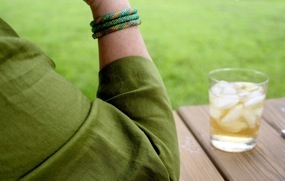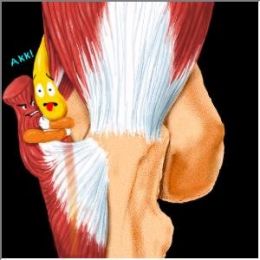Cubital tunnel syndrome or "ulnar neuropathy at the elbow" is caused by compression of your ulnar nerve at the elbow; this is the same nerve associated with “hitting the funny bone.”
 Compression of your ulnar nerve can be from external sources of pressure (leaning the inner part of your elbow on a hard surface), traction (from holding your elbow flexed for a long time, which probably happens while you are sleeping), or subluxation (when your nerve “pops” back and forth over the bony bump, or medial epicondyle, behind which it normally tracks). This has been termed “cell phone elbow” because people who hold their cell phones up to their ears for long periods of time can feel symptoms. Anatomically, sometimes the muscles or other soft tissues surround your nerve can become thickened or scarred and lead to internal sources of compression.
Compression of your ulnar nerve can be from external sources of pressure (leaning the inner part of your elbow on a hard surface), traction (from holding your elbow flexed for a long time, which probably happens while you are sleeping), or subluxation (when your nerve “pops” back and forth over the bony bump, or medial epicondyle, behind which it normally tracks). This has been termed “cell phone elbow” because people who hold their cell phones up to their ears for long periods of time can feel symptoms. Anatomically, sometimes the muscles or other soft tissues surround your nerve can become thickened or scarred and lead to internal sources of compression.
 Cubital tunnel syndrome symptoms include pain, numbness and tingling in the ring and small fingers, and, when severe, weakness in pinch, grip, dropping objects, and loss of sensation.
Cubital tunnel syndrome symptoms include pain, numbness and tingling in the ring and small fingers, and, when severe, weakness in pinch, grip, dropping objects, and loss of sensation.
Physical examination can help diagnose this. Electromyography (EMG) and/or nerve conduction study (NCS) might be performed to confirm the diagnosis of cubital tunnel syndrome and stage its severity, as well as to look for other sources of nerve problems.
Conservative treatment might be an option if your compression is not severe. Activity modification including avoiding leaning on your elbow, using a handsfree device if you spend a lot of time on the phone, and keeping your elbow straight at night can help alleviate symptoms. Some people who have ulnar nerve symptoms spend a lot of time on their devices texting or reading (rather than just talking) now. If limiting this is not an option, you can try enlarging the font and/or using a stand for the device so that it can be held with your elbows straighter or propped in front of you so that you do not have to hold it at all.
There are some commercial “braces” that can help you keep your elbow from bending at night. Sometimes, an elbow pad flipped backwards will do the trick. Many people find that the most comfortable method is to wrap a pillow or big towel around your elbow and tape it at night. It might sound ridiculous and might take time to get used to, but it really can help ease the irritation of your ulnar nerve.
Severe or progressive nerve compression can be treated surgically. Decompression of your ulnar nerve around the elbow with or without “transposition,” or moving your nerve toward the front of the elbow to avoid stretch or compression, is performed. Postoperative care can include activity modification and therapy. Your symptoms can take many months to resolve, and unfortunately, might never resolve completely.
*See also High Tech Elbow Pain